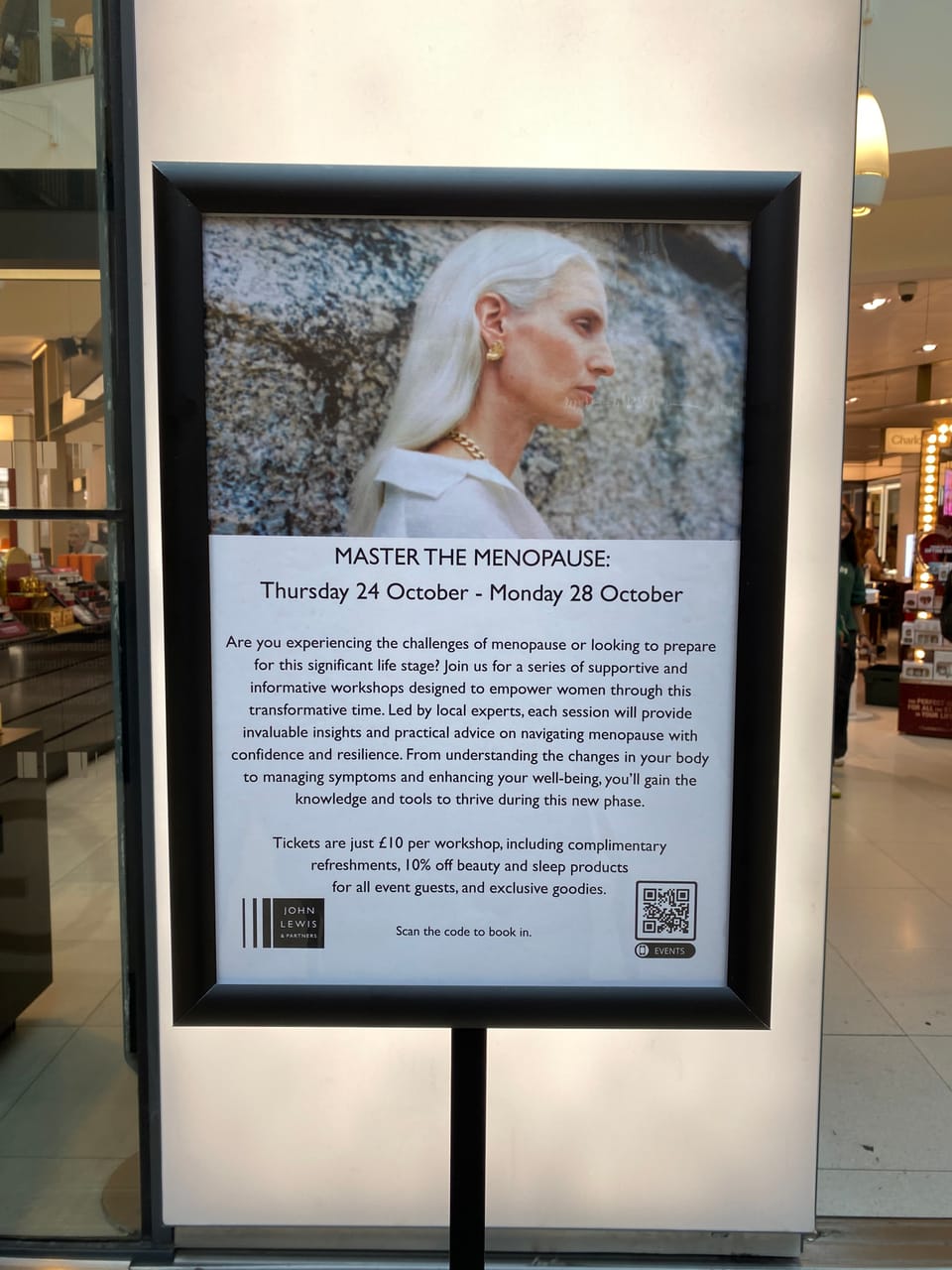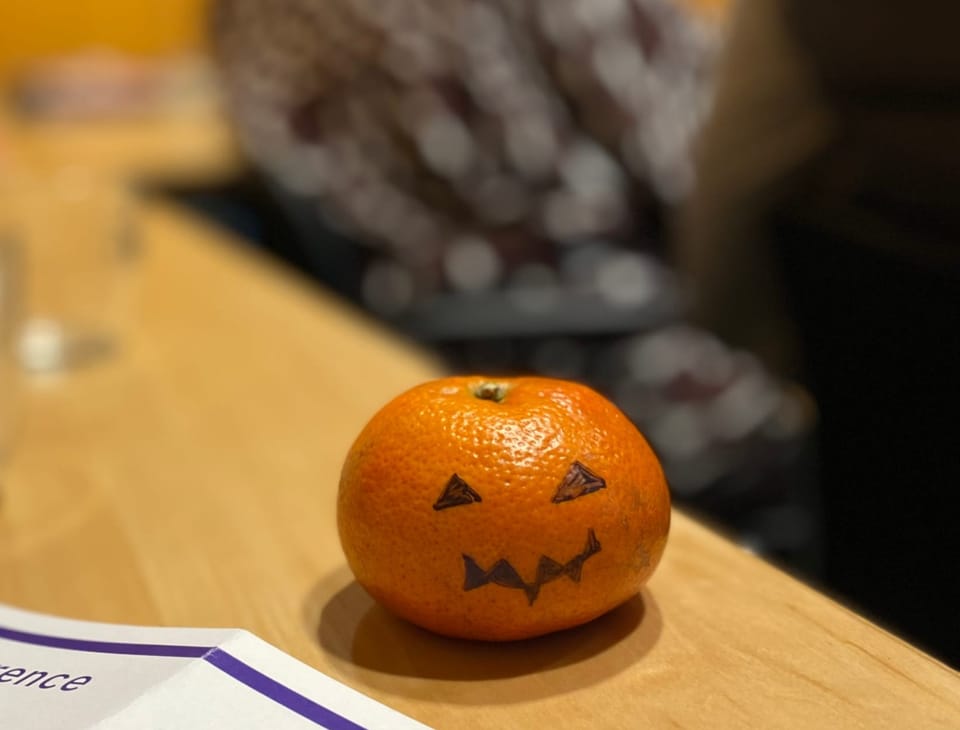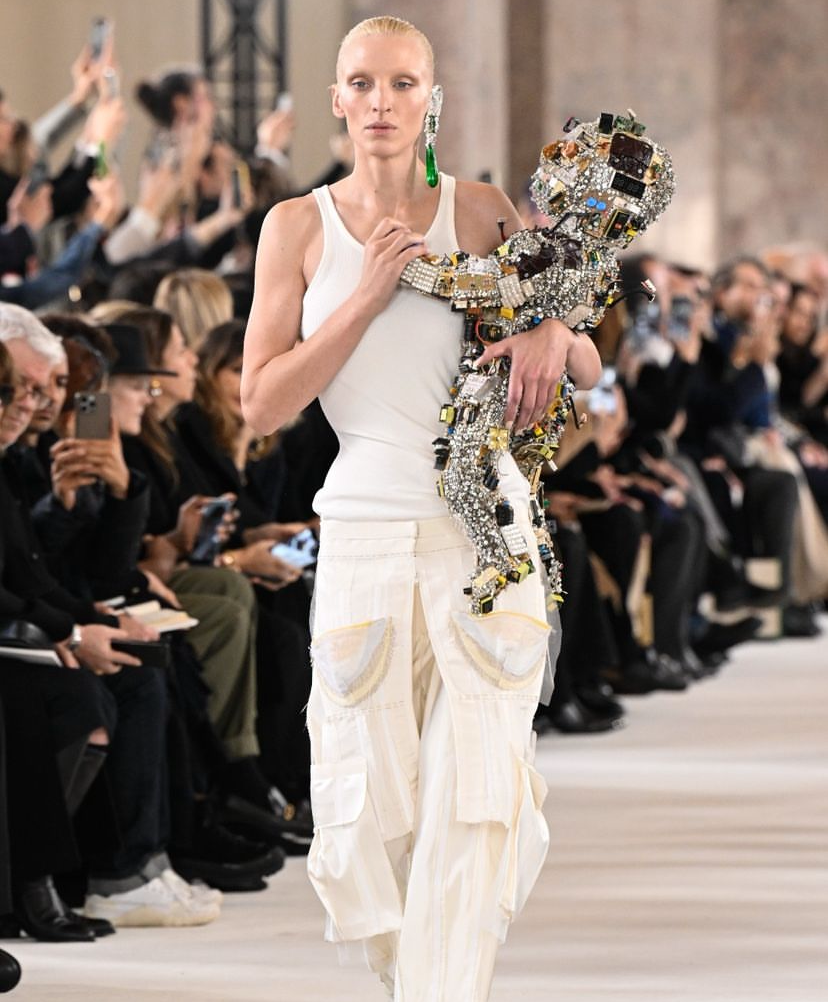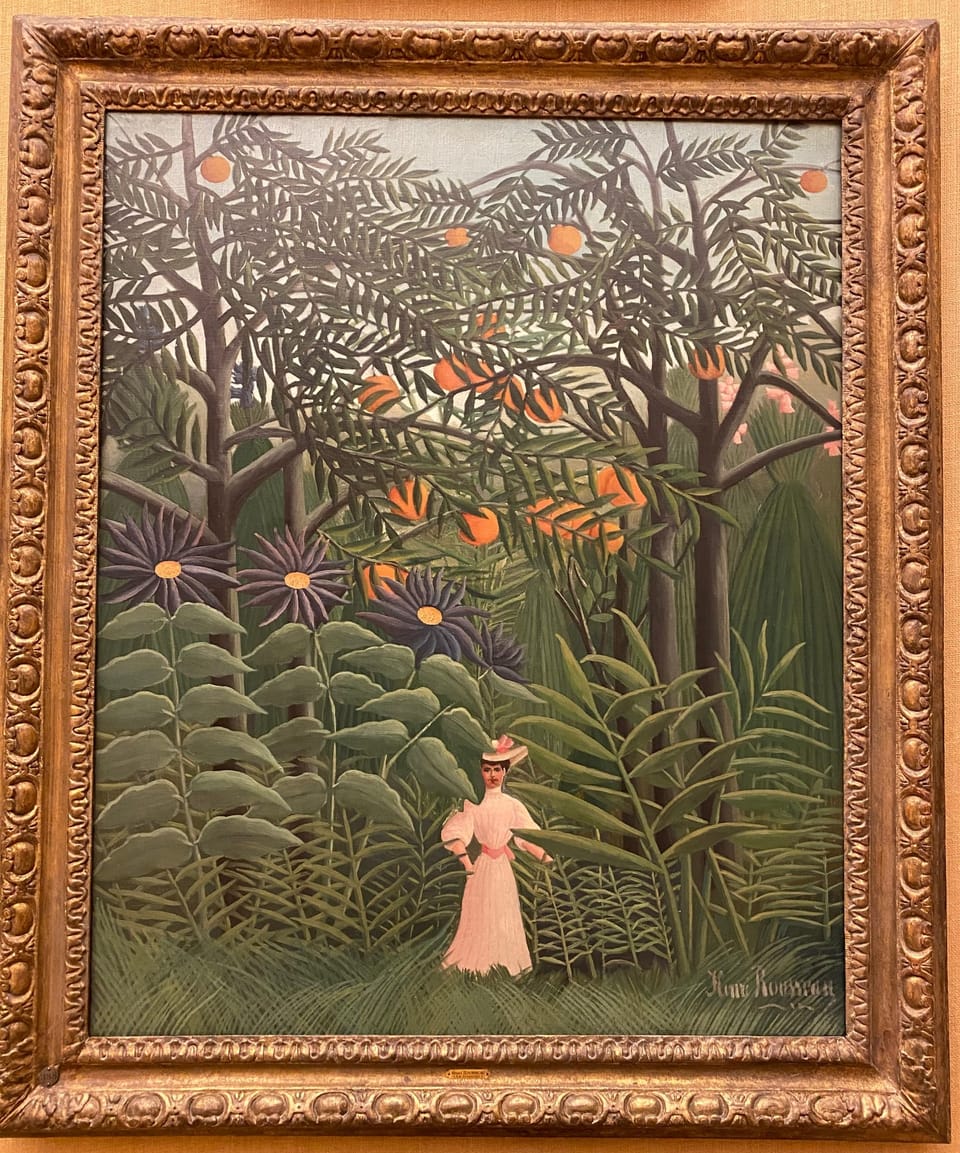Still Blooming
The language of menopause and managing the body/brain/social split by transcending it.
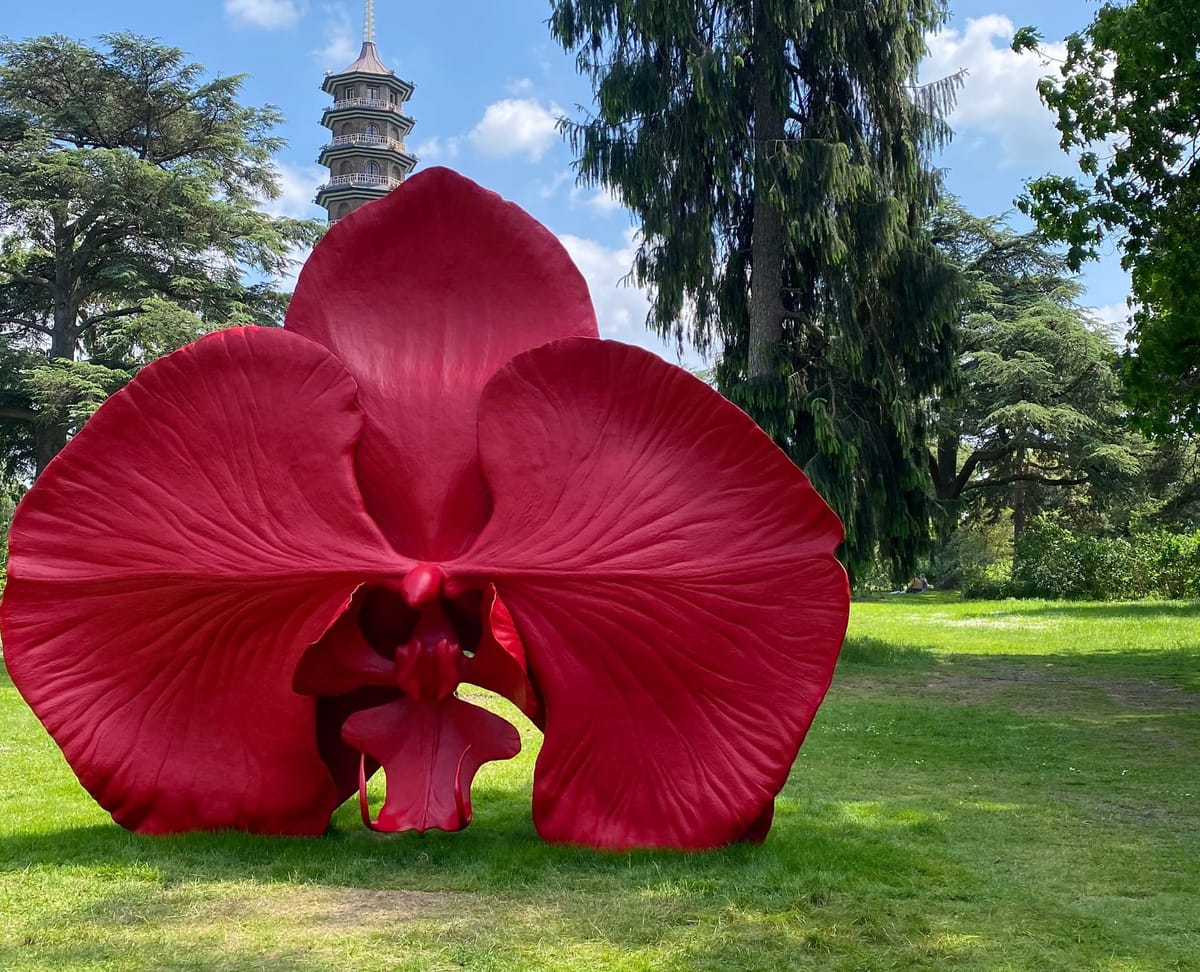
I searched my phone’s photo library with the word ‘menopause’, because I have been photographing and screenshot-ting things associated with this word for the past year. The two most recent images are a screenshot from a group chat, and a photograph I took in Mexico City in early August this year. I am trained to pay attention to the semiotics folded into visual forms. In other words, how visuals - advertisements, TV shows, memes, selfies, surveillance footage, whatever - speak: what they say, how they say it, what meanings are conveyed by this speech, and what this means for contemporary culture and politics. If you’re like me then this is a capacity you cannot turn off, which is an interesting occupational hazard in a time when our realities are to a considerable extent constituted by the visual. (A hat tip to my friends Wesley Goatley and Pedro Oliveira who bring my attention to how we hear and what we listen to). So in this post I bring some of that attention to visuals to thinking about how we talk about and think about menopause. Here’s the first visual, which is actually a screenshot about language.
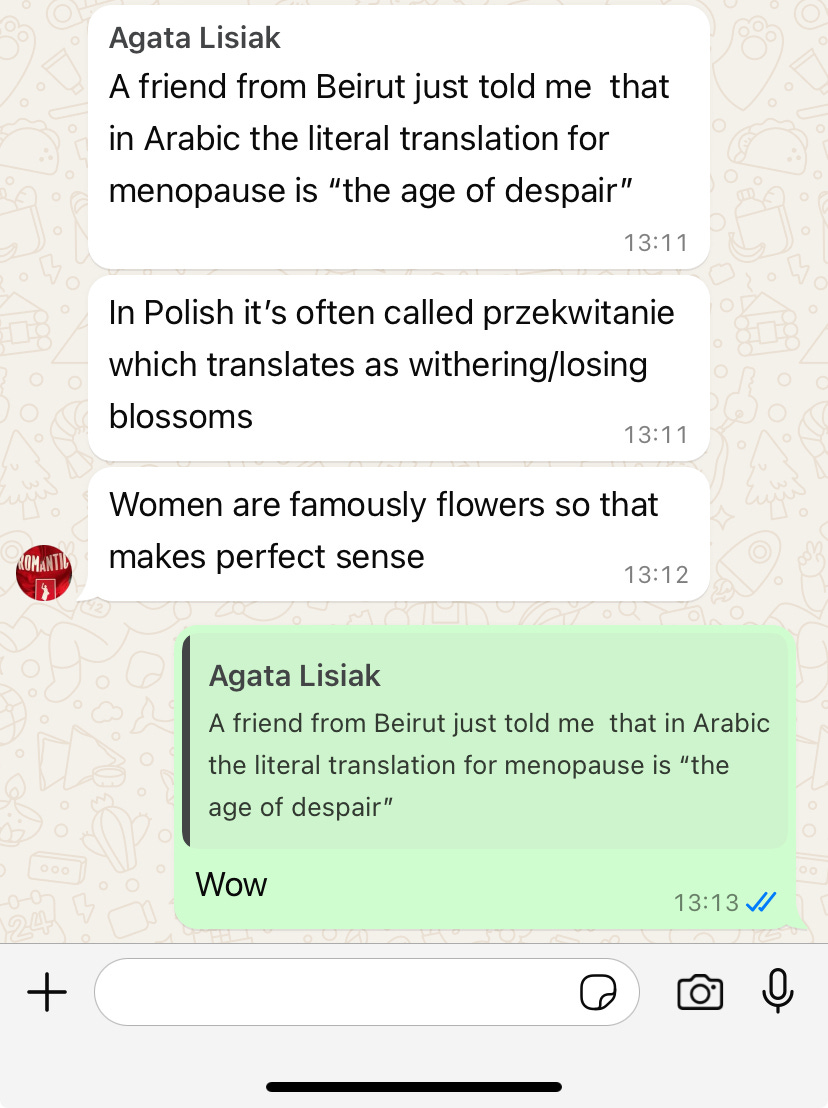
Screen shot from a group chat with friends including Berlin pal, Agata Lisiak.
Thanks for reading M’s Substack! Subscribe for free to receive new posts and support my work.

Image taken by me in Mexico City, August 3, 2024.
Female sexual and reproductive body parts are associated with fruits and flowers, symbols of fertility. Losing your virginity is referred to as being ‘de-flowered’, ‘the cherry’; the ‘birds and the bees’ refers to pollination i.e procreative sex. Plus, this is all about nature; heterosex and procreation are considered to be acts of nature and hence things that go against this [arbitrary] notion of nature are considered deviant. ‘Nature’ is actually ‘culture’, something created and made by us. which we typically think of as a powerful, mysterious force separate from human being. The flowers and the bees come together nicely in this trippy video by Run the Jewels.
By this logic it makes perfect sense that dying, dry, and withered flowers, refer to the cessation of reproductive capabilities. You can no longer bloom; your purpose - to reproduce - is now impossible. The language of advertisements for skincare treatments and serums to bring radiance (back) to one’s aging face evokes this metaphor of withered flowers. I write these lines today as I notice lines on my forehead that never existed. Either that or my eyesight has gotten very good. This lines up with Agata’s message about the word for menopause in Polish. What I can find via Google Translate is that ‘menopause’ in Hindi is रजोनिवृत्ति (Rajonivrti) that sounds like it comes from Sanskrit; '‘Nivriti’ refers to ‘retirement’. And in Tamil it is இறுதி மாதவிடாய் (Itrthi maathvitai) or final menstruation. No flowers here, just the facts. What are other metaphors for menopause in other languages? I would love to hear more words and phrases from other languages and cultures, so please do share in the comments section.
And then there’s the other dominant theme in the language of menopause that interests me - ‘madness’ - as the image taken in Mexico City suggests. The image refers to a theatre production about a woman who is victim to her hormones and goes ‘crazy’. Look at how she looks. “It’s the fault of the hormones!” It is definitely true that hormonal fluctuations make us moody, irritable, angry, and sad. PMS is absolutely horrible. Something similar but different is happening in perimenopause. You are being depleted of estrogen so your hypothalamus, thyroid, and pituitary gland, which are all implicated in this depletion, are like lights flickering in a thunderstorm. Hence the regulation of sleep, appetite, mood, cognitive clarity, and body temperature are off-kilter. This is also why you have lost your dermal radiance. (Life/the world can also kill the radiance in you). Estrogen is a key enabler of plump, soft, and supple skin. This is not about being pretty or beautiful; If you’re young, then you’re automatically gorgeous because of estrogen. (I will not be taking any questions at this time.)
There’s another interesting trope in the poster for the Mexican theatre production. It is the juxtaposition of the young, white, blond, hench man, with the chaotic, sweaty woman. I have not seen the play and given the pout and “bedroom eyes”, I want to assume that this character is framed in sexual terms. The production seems to be set up as a bedroom farce (‘100% risas’, i.e laughs) Perhaps there is a sexual connection between the characters that defies reason? Which is hilarious because the older person/younger person sexual dynamic is extremely common in fiction and in life. As is [what we think of as] sexy people hooking up with [what we think of as] unsexy people.
At this point I feel I must integrate one of the funniest things ever put on television, Fleabag, and the clip about sexuality, the body, and menopause featuring the tremendous Kristin Scott Thomas and Phobe Waller-Bridge. I am not alone, I know, in being upset that Scott Thomas went off to have another martini. The entire clip is such a thoughtful provocation.
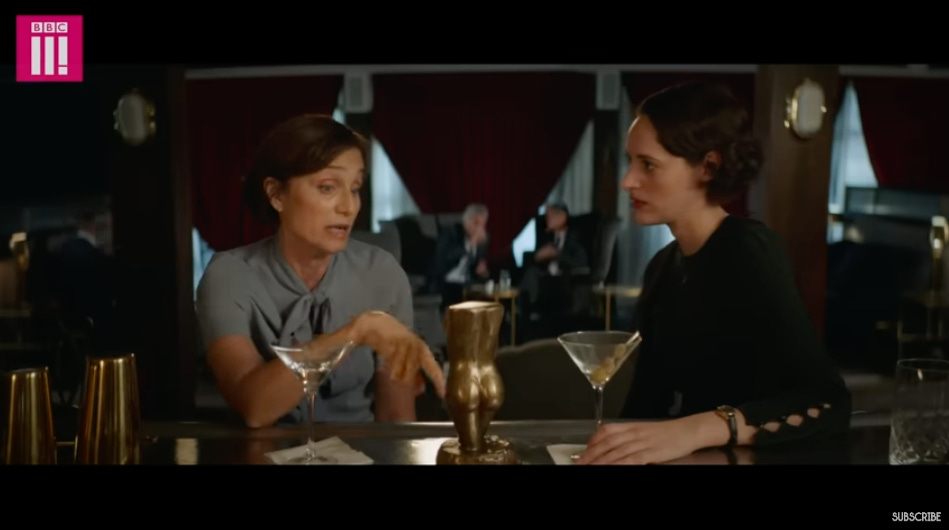
Screenshot from the Youtube clip linked above; Friday, 6 September 2024.
The juxtaposition in the Mexican theatre piece, and in what Scott Thomas talks about is between body (hormones), and reason, usually considered to be a cognitive function of the brain. However your brain is also part of your body, and both are influenced by what happens around it, inside and outside it. I think this as an uneven three-way: body, brain, and the social. We generally like to think in binaries.
In a future post I want to write more about the excellent Miranda July novel, All Fours, because it deals with perimenopause, and re-negotiating desire, sexuality, and relationships. For now, I’m thinking about one point in the novel in which the protagonist, a fictionalised (perhaps) version of the author, July, encounters a chart showing that estrogen levels drop precipitously off during perimenopause. This cliff brings her great anxiety and some rage. She conducts research among her peers about this cliff, about living with and past it, and much of the novel is about her own whimsical journey of standing on the edge of that cliff. July keeps us on our toes: is this (chaotic, out-of-character, impulsive desire) all in my head, and the things happening in my body - can I really control them? Should I give in to the utterly de-stabilising hormonal drop and just go with it? Falling is also flying (?)
Hormone Replacement Therapy (HRT) gives you PMS-like symptoms but without an actual period. One day, I found myself feeling … blue. It has been a while since I had that distinctly PMS-type blue-ness, so I suppose I had just forgotten how it felt. Small mercies. It is absolutely amazing to not have PMS anymore. It is important to say that I have never been on the pill and cannot talk about what entering perimenopause or menopause is like after being on it. I know the pill changes the experience of it, and it also can improve - or worsen - the experience of PMS. When I realised that the feeling was just PMS, I was able to snap out of it. I actually laughed out loud when I realised what it was. My life/job/the world are not terrible! I have not totally fucked up my entire life. It’s just PMS. Phew.
The ‘crazy’ hormonal woman is easily caricatured, even within ourselves, and it is infuriating because hormones are not something we can turn off or completely control, although there are things we can do to minimise their effects at different stages in our cycles. Most of us can and do, but only through a process of brute force/trial and error. And once you discover what works, being able to maintain that state of balance can be difficult because we are in the world, not sequestered in some cave for a week. I will admit however that on some occasions I have thought that time off work during PMS or the menstrual period might make a lot of sense, but I am not going down the menstrual leave policy debate right now.
Jane Ussher’s Women’s Madness: Misogyny or Mental Illness? explores the history of the biomedicalisation of women’s mental health, and the resistance to seeing mental health as entwined with social, psychological, and cultural factors. Informed by her own mother’s struggles with mental health, Ussher considers a range of theories and approaches to women’s mental ill-health, and weighs up traditional medicine and psychiatry against feminist critiques, and more socio-biological, socio-psychological, and cultural theories.
Writing in the late 1980s-early 1990s (the book was published in 1991), she suggests that social conditions of gender inequality, and the ‘neuroticism’ of the nuclear family, have much to do with women’s mental health. But not entirely. She remains uncertain because there is biology to contend with, and hence wants to advance a multi-dimensional approach. The understanding that poverty, lack of education, familial and partner violence, chronic unemployment, and discrimination diminish mental health outcomes is more widely accepted today, even as pharmacotherapies for depression, anxiety, and other conditions are extremely widespread and benefit many people.
However, from ancient Greek Science Bros to Sigmund Freud, ‘hysteria’ (a catchall for women’s mental ill-health) was thought of as a uniquely female affliction, a malady of the ‘wandering uterus’. Hystera is Ancient Greek for uterus. Uterus-having people’s ‘madness’ was understood both scientifically and in terms of demoniacal possession and treated with everything from herbs to sex to sexual abstinence, hysterectomies to clitoridectomies. Ussher writes about the incarceration and violent treatment of women in infamous hospitals like Saltpetriere in Paris and ‘Bedlam’ in London, the former being first a jail, and then a hospice/hospital. There has always been a troubled connection between people we consider to be criminal and unwell. Saltpetriere was also known for being the site of experimental research (including hypnotherapy) on women thought to be deviant and unfit to participate in society, from the criminal to the epileptic.
Alan Sekula, the American photographer and essayist, writes in the excellent, The Body and the Archive, that political-economic imperatives of industrialisation in the 18th century required that some bodies be considered ‘fit’ for work; hence, the unfit needed to be identified and managed. From the 18th century ‘hysteria’ began to be associated with neurology rather than reproductive organs. However, it was only in 1980 that ‘hysterical neurosis’ was struck from the Diagnostic and Statistical Manual DSM-III. Here’s an excerpt about the persistence of ancient thinking about uteruses into the recent past in a great article about the history of hysteria:
During the Victorian Age (1837-1901) most women carried a bottle of smelling salts in their handbag: they were inclined to swoon when their emotions were aroused, and it was believed, that, as postulated by Hipocrates, the wandering womb disliked the pungent odor and would return to its place, allowing the woman to recover her consciousness [34]. This is a very important point, as it shows how Hippocrates’ theories remained a point of reference for centuries. The problem as Ussher and countless others argue, is the notion that mind/body are split from each other, and from the social. Depending on what kinds of mental health we are talking about, and where along a spectrum of science beliefs you lie, you might also consider that health and well-being extend across these places. Brains and minds and bodies are considered to be firmly entwined. Disentangling one from the other might be a fool’s errand when it comes to hormones whose function is to modulate the things that constitute us and who we are and how we present to and act in the world: affect, mood, cognition, libido, sleep. We are in a time when we can measure patterns of heart rate, skin temperature, steps, blood glucose level and so on. But correlating these measures over time with particular outcomes and using this to manage and predict the flow of our days is possible with effort and focus, but is also tricky. It is tricky if we’re chasing the holy grail of cause and effect: That particular measurements are indicative of actual internal states, and we believe this knowledge will afford us control, efficiency, and freedom. Freedom from what, to what?
Hormones are different from heart rate and blood glucose level because hormones are catalysts, they are not necessarily outcomes in themselves that can be measured by external monitors such as quantified self/self-tracking devices. Nonetheless we can and do measure hormone levels via routine blood tests. That is a little different from knowing what those test results mean for you and how it fits into perimenopausal health and well-being. I believe that a move towards personalised hormone mapping in places like the United States is gaining traction because women who want to get HRT have to advocate for themselves. HRT is not as readily accessible through the health care system as it is in the UK. (Thanks to Sheena Matheiken for sharing this). This is also related to the rise of the perimenopause-hormone-wellness doctor who does the work of interpretation of results for you via Instagram or Substack. I think it is also worthwhile flagging that there is a significant menopause/hormone misinformation and influence industry that makes discussions and casual research about this topic online charged and difficult. I’m thinking about how to navigate this in this Substack and in my life.
My own take on individualised data from quantified self practices is that they could do more for broader scientific research rather than individualised attention to the body, not unlike how period-monitoring apps have contributed to epidemiological research, despite data privacy concerns. I imagine that as more Millenials enter perimenopause we will see more women’s health tech monitoring and management apps mature. The broader point remains that how we attend to the managing of symptoms of hormonal activity through measurement can be fraught. Or, that when it comes to perimenopause and menopause, data-driven management as a way of knowing what to do and how to live, might have its limits. I am not an aggressive self-tracker though and I am attentive to the limits of self-tracking as self-knowledge. I hate that feeling of having knowledge, insight even, but not being able to act on it.
Lisa Mosconi’s The Menopause Brain takes what I think is a balanced approach in the see-saw between health and wellness as slow/organic/naturopathic/long term preventative processes, and the medicalised/data-driven/Western-scientific/clinical management process. It is balanced because, in the vein of Ussher, Mosconi talks about the brain as part of the body, mind, and the social. This is something I am always trying to do myself, for myself. So I want to try to minimise the emphasis on hormones per se because they keep bringing the attention back to something I cannot always control.
Back to Miranda July, finally, who deftly navigates the body/brain binary because, I think, she is an artist. All Fours is, among many things, about creativity, the experience and practice of which, are, maybe one of the few ways that binaries, or the three-way split, are transcended. And here I refer to creativity in terms of re-creating the self. The withering, the craziness, and the loss of radiance are words we need to actively drop, ideally off a cliff. The instability is real, peri-menopause can be terrible, but there are ways to manage it just like we managed PMS. Sometimes well, sometimes terribly, but always trying. Yes to health and well-being, and there is a lot of information about this available.
For myself, I am realising that focusing on the incredible emotional, psychological, and personal transformation taking place is the ticket. That feeling of coming into your own, becoming proper friends with yourself, and seeing your self as not a failing project to drag around, worry over, and improve. The Kristin Scott Thomas character is right when she says, it all gets better after it gets horrible.
I want to think about menopause as a time to re-create the self. I wish I had had some notice to plan for this through a drawn-out perimenopause. Instead, it all happened so quickly and unexpectedly. But I’m doing it now. I think it is fitting to end with a photograph of a bouquet that my friend Lucy Chambers sent me congratulating me on arriving at menopause.
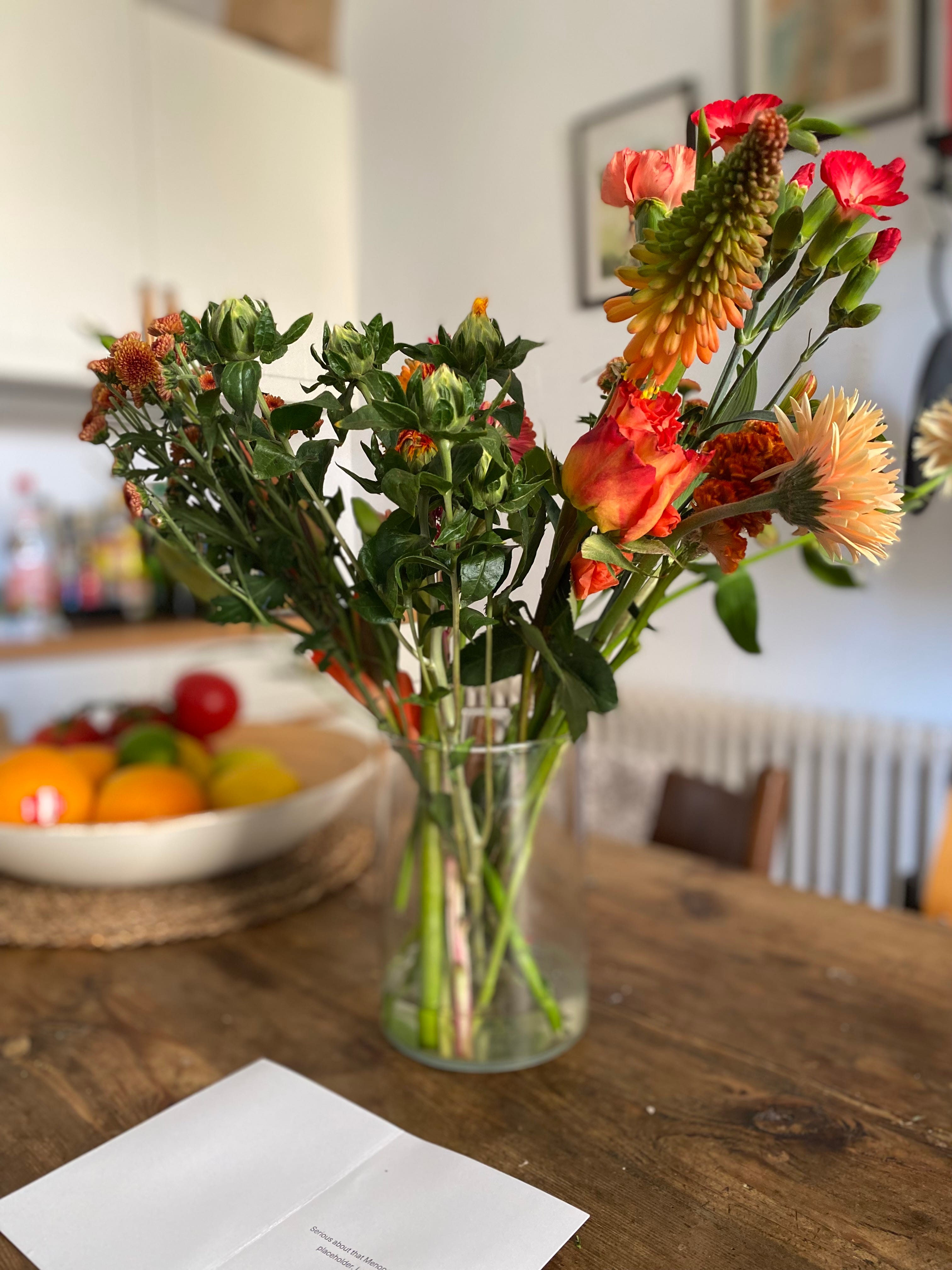
Thanks for reading M’s Substack! Subscribe for free to receive new posts and support my work.
